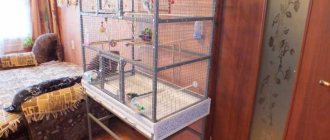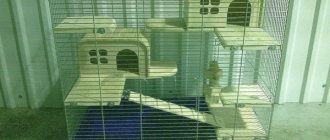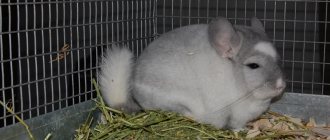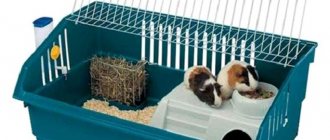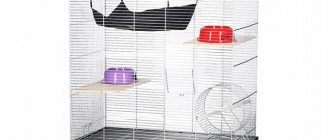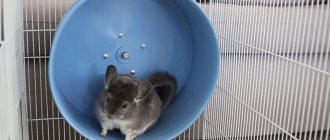Cell project
Rodents are very mobile and active, and they also do not like to live alone. Therefore, they need a spacious, possibly multi-story cage, various labyrinths and a wheel.
Considering the size, remember that at least 75x35x50cm is required for one animal. If you have no idea what the design should look like, you can look at photos of chinchilla cages on the Internet.
Tall multi-story structures are better suited for apartments. In private homes, you can afford a larger size and place a lot of toys in it.
We do not recommend immediately taking on complex projects with a large number of loopholes. A much better solution would be a lighter design that you can redo over time. Drawings and diagrams for creating cells can be found on the Internet.
What kind of cage should a chinchilla have and where should it be placed?
Chinchillas are very active animals, especially at a young age, they love to jump high, climb on different shelves, and run, so the cage must be large enough to satisfy these needs of the animals. The height of the cage is especially important; for chinchillas, the higher the better. Experts believe that the optimal cage size should be about 1 meter in height, and at least half a meter in width and length.
In general, you can place the cage anywhere in the apartment; there are no clear rules about this, but there are some notes that will help you choose the right place for the chinchilla’s house. The cage should not be in a draft, as your pet may catch a cold; a place near a radiator is also not suitable, because the maximum temperature for chinchillas to live comfortably is 26 degrees. Your bedroom would not be the best place for a cage, because these rodents are active at night, they will simply disturb your sleep.
Tools and materials
Before you begin construction, you need to select the material to create the cage. Wood is best suited for this, as it is a pure biological material. It is also easy to process.
All sorts of sticks and small boards will not be lost. They can fit perfectly into the animal’s play area.We cover the frame with rods or mesh with small cells. We paint it well so that corrosion does not occur, and the house will serve you for many years.
Read here - How to make a greenhouse with your own hands: step-by-step instructions and design options. Review of the simplest and most current projects (95 photos and videos)
We will build the cage using metalworking tools:
A drill will help you drill or connect wood together. Also, for its full operation, drills are needed.
To cut wood, do not forget a saw - a hacksaw.
Check it out here too!
Do-it-yourself barbecue from a gas cylinder: step-by-step instructions, choosing the optimal sizes and tips for choosing projects (110 photos)- Do-it-yourself winter chicken coop: design, layout, insulation, heating. 80 photos of warm chicken coops
How to make a snow blower with your own hands: manufacturing methods, diagrams, drawings, construction options and application nuances (100 photos + video)
Nailing nails of different sizes is done with a hammer. It's also worth taking for work.
To make the product as even as possible, we help ourselves with a level. All measurements are taken with a ruler.
You can mark dimensions on the material with a pencil or marker. A utility knife can also be useful for small work activities.To make your work easier, take a jigsaw. If you don’t have it because you don’t need it, it is advisable to ask your neighbors or friends so as not to spend extra money.
Cutting out metal parts is carried out with special scissors.
For a new design, it is better to purchase locks, latches and hinges in hardware stores to be sure of their strength and your animal cannot get free.
Check it out here too!
How to make a pump with your own hands - step-by-step manufacturing of a pump and options for making simple and effective pumps (95 photos + video)Do-it-yourself hot smoked smokehouse: 100 photos, review of the best drawings, project selection and construction options
- How to make a cage for a parrot: basic requirements, tools and materials, step-by-step photo instructions. Tips from experts on arranging a cage
Pull-out shelves, all kinds of wheels and various metal hinges - you need to stock up on everything you need. But we make the chinchilla cage itself with our own hands.
Main characteristics of a cage or display case for a chinchilla
A cage or display case for a chinchilla should have a number of characteristics:
Firstly, it must be well ventilated.
Secondly, you should pay attention to the material from which it is made. It can be metal, wood or plastic. We recommend purchasing a house made of metal. This, by the way, is the most budget option and is perfect for keeping an animal at home.
Chinchillas are rodents, and they will definitely try everything, so the material of the cage and its contents must be safe and reliable . Therefore, it is recommended to buy a cage with galvanized rods.
The permissible distance between the rods is 2 cm, which will ensure the safety of the animal.
If you get two chinchillas at once, we recommend purchasing a display cage, because it is the most spacious. The minimum size of the display case for each animal is 80x80x50 cm. They are made of laminated chipboard or aluminum. Choose what you can afford, but keep in mind that aluminum is more reliable, and a display cabinet made of laminated chipboard will most likely fit much better into the interior of your apartment.
The size of the display case you need depends on the number and gender of your future pets, because if you get two animals of different sexes at once, then they will definitely have offspring soon, which means that there should be even more space in the house. In the display case it is necessary to place several shelves, a hammock, and houses for animals.
And don't forget about ventilation! In a cage made of twigs, this does not arise, but if you purchased a display case, then a mesh should be installed on one or both sides, then the air will spread throughout the house, and the animal will be comfortable!
Construction
We start after purchasing materials. If you are making a cage at home, then equip and prepare the place in advance. A sufficient amount of light is necessary, as the work will take a lot of time.
We create a drawing of our cell and transfer the dimensions there. Do not rush to cut out parts; it is better to check all the measurements several times.You can watch different videos on how to make a cage for chinchillas to have an accurate idea of the work ahead.
We cut out a rectangle from this material to size - this is the future base of the cell. It must be covered with clapboard or a plywood sheet on top.
Check it out here too!
- Do-it-yourself trolley - how and from what to build a decorative and tool trolley (135 photos and videos)
DIY nests for laying hens: drawings, tricks, best solutions and tips on how to make nests correctly (115 photos and videos)
- How to hem felt boots with your own hands: materials, tools, useful tips for hemming. Step-by-step instructions with photos + master class with video!
We install a removable tray on the base. If you decided in advance that it will not be there, you need to treat the material with water-repellent substances. Because chinchillas will go to the toilet and water may spill from the drinking bowl.
We vertically fasten the bars with self-tapping screws, ties or nails to the base in the corners. This way we will create the frame of our cell.
The top of the frame is done in exactly the same way. You can install an additional horizontal belt. This will strengthen the structure and help create additional shelves.
Metal rods or mesh are stretched over the frame. We fix it with nails or screws to the base. Make sure that there are no sharp protrusions sticking out anywhere that could injure the animal. To do this, you can install a metal strip.
Cleaning will be easy if you have several doors and a top that can be removed. We fasten the doors with hinges purchased at the store. We make frames from lining.
If the building has several floors, it becomes necessary to place stairs between floors. It will be much more fun and interesting for the animal to live in a house equipped with various loopholes and labyrinths.
Use your imagination when creating these things, but don't make them too small. Otherwise, you will have to destroy your product while rescuing the stuck animal.
Chinchillas are very sensitive rodents and even a small draft can provoke illness. To prevent this from happening, we cover two adjacent walls with wood. It is better to place the cage approximately 50 cm from the floor.
You can make a convenient shelf or frame. It may contain toys and care products. Do not install it near furniture or interior items. The animal can spoil them
We buy treatment products from construction or pet stores. You need to coat the inside with the solution to ensure that your chinchilla has an antibacterial living environment.
The outer part of the structure is varnished or painted. These are important measures to protect metal from corrosion and wood from rotting.
After reading our article, you can understand that it is not at all difficult to build a cage for a chinchilla with your own hands.

